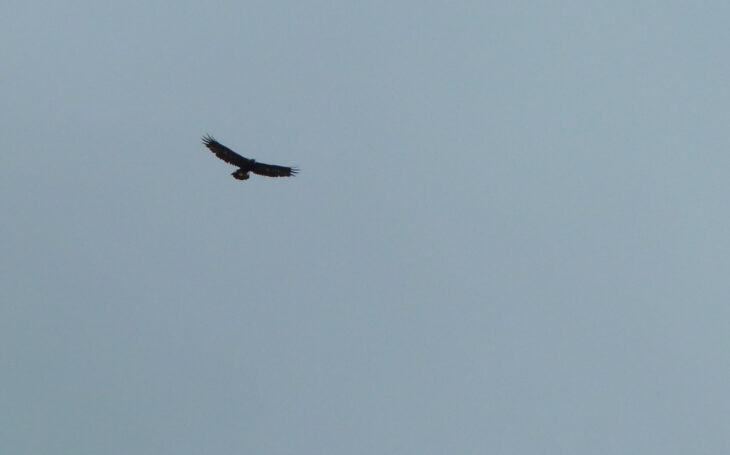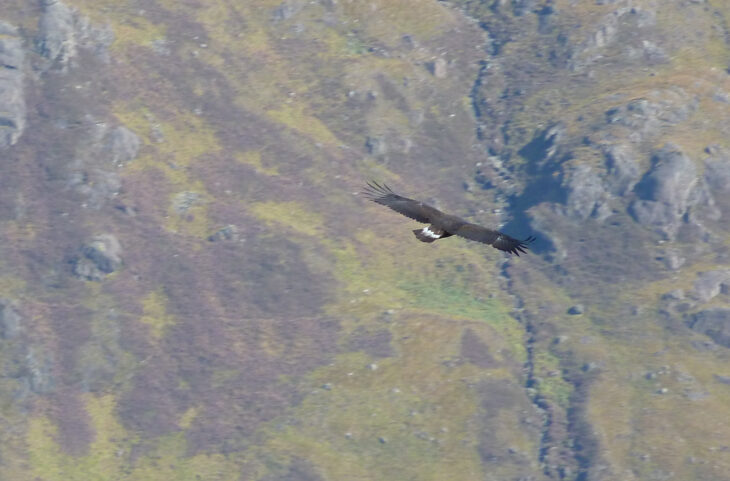Eagles of Rahoy – the final chapter
We recently featured the story of a resident golden eagle nest on our Rahoy Hills Wildlife Reserve. Nestled in the wilds of the Morvern Peninsula, Rahoy Hills is home to a huge array of wildlife from red deer to rich arctic-alpine flora. In the final part of this series, Rahoy Hills Ranger, Steve Hardy, concludes monitoring the eagle nest. You can find part one of the series here, part two here, part three here and part four here.
The dry, settled weather continued. People here, including me, enjoyed it. We get so much rain here in the west for weeks and months on end, our summer last year was so dreadful, so that long settled blue sunny day after blue sunny day was so welcome. But of course, it was unnaturally dry for too long, it wasn’t normal, and hill fire risk became extreme. I remember the day it came to an end; I was expecting it as it had been forecasted. I could see the cloud to the west coming in, but it was like it was the blue sky that was leaving and moving away. I watched it go and wondered when we would next see such a sky. I know it had to end, and we needed it to, but I was sorry to see it go.
I was next up checking the eagles on the 22 May. On my walk in I didn’t feel any fears that anything would be wrong, I’d lost that feeling. The chick was visible and active on the nest. After some time, a parent flew from the nest ledge, I hadn’t seen it in the shadows. It gained height and circled away, but not far, returning to the ledge after just 5 minutes, disappearing in the hazy shadows again. The chick was now almost a month old. All was well.

After the settled spell ended it became difficult to find a good enough day with good enough visibility to check the eagles (and do my butterfly monitoring, for which I need sunshine), and like last year, following a dry settled April and most of May, the weather became very unsettled with many days being so windy for the time of year, with low temperatures and some terribly wet days.
2 June was a suitable day for a watch. It was overcast so the light was very good. I set up the scope, and could see the chick on the nest, great. I watched and watched, it wasn’t moving. Normally even a resting well fed chick will do something once in a while, lift a wing, sit up, lift its head, shuffle about and change its position on the nest, something, but…nothing, no movement. I stared and stared through the scope, looking for a movement, was that its head moving? I couldn’t be sure. An adult comes in. Relief! But the chick doesn’t move or respond, and the adult stays for only seconds, it leaves something on the nest, prey or nest material I couldn’t tell, then leaves. Ten minutes later an adult comes to the nest again. Again, there is no response or movement from the chick. I watched and watched. Nothing. I had become so cold again. You become so absorbed you don’t feel the cold. I could have looked through the scope forever willing the chick to move. It still hadn’t when I left, and I was certain it had died.
It was windy, cold and bleak high up. It felt so wrong, this weather, these temperatures, this wind, for June. The eagles having failed, the hills having so little life in them, everything felt so desolate. I phoned my line manager, Abi, to give her the news, and to be honest because I needed someone to talk to. I had to get out of the wind and as I told Abi I was in tears.
I couldn’t think of anything else on the long walk back but the eagles. I felt like I was fighting a losing battle, fighting for nature. Nothing could lift how I felt.
I spoke to a couple of eagle friends that day, with many years of experience between them of monitoring golden eagles. They said that although what I’d seen didn’t sound good, it wasn’t conclusive. They said it’s possible the chick had had a good feed before my watch and also said that it was encouraging that an adult had come to the nest. Was there still hope that it was ok? Maybe?
I wanted and needed to go up again as soon as possible to confirm things. More wet windy days followed, but on 6 June, the Friday after my last visit, the forecast was ok. I was up on the viewing ridge early; it was really difficult to find a sheltered spot out of the wind that was blowing straight from the direction I needed to look. There had been heavy showers on my walk in, and I could see that more were coming. For three hours I watched the nest. Nothing. No sign of life. I found an adult on a favoured skyline perch. After three quarters of an hour, it left and flew to the opposite side of the hill. During my watch there had been two heavy showers, and it was cold. A parent should have come in and sheltered the chick, I’d have thought, even at a month old. But let alone that, the nest was lifeless. I was desperate to find the chick sitting up, to see it moving, to see an adult go in, but nothing.
They had failed.
I could not watch the nest 24/7 and don’t have intimate close views of the nest unlike the ospreys at Loch of the Lowes, and so can’t say for sure what happened, but I would say it would have been the change in the weather which included several truly wet, cold, windy days. This would have not only made the hunting of the very little prey that there is on the hill harder for the parents, but it also would have meant the chick would have been exposed to these weather conditions. The parents would have had to have been away longer, trying to catch something, therefore leaving the chick exposed for longer periods. The nest site is not the best, it has no overhang above it, so there was no shelter for the chick.

When I started writing this blog series, I knew that there was a chance that it might not have a happy ending, and in fact wasn’t expecting it to, but when the chick became weeks and not days old, I thought it was going to make it.
It is as important to tell sad, tragic stories as it is happy ones. Telling them instils a desire in people to want to make things better, so that in the future there is less chance of sad endings happening again. Telling these stories makes people care and want to bring about change. I so much wanted for the story to go on and to be able to write about the young eagle growing up and being on the wing later in the summer. That I couldn’t isn’t going to mean I’m going to give up, as hard as it is to keep telling sad stories, I’ll keep telling them in the hope that in doing so those changes will come.
The Rahoy Hills eagle pair have been together for years. Hunting together, roosting together. Enduring all weathers together. In the late winter they will have strengthened their bond, courtship flying above their territory. They will have chosen which of the nests they were going to use and rebuilt it together. Both of them would have incubated the eggs for over forty days. The male had hunted and provided food for almost a month. The female would have fed the chick, sheltered it, kept it warm at night. The male would have spent the nights close by the nest.
Scientists will say that it is all instinct. That the parents would have no feelings and therefore the mother would have felt nothing when the chick didn’t lift its head anymore when she tried to pass food to it. But, whatever, they had a purpose, a drive, every day, to provide and protect the chick. That suddenly stopped. I pictured the male performing his undulating territorial display earlier in the spring, flying into the nest with prey, the female feeding the chick, settling back over it after feeding it to keep it warm, and now seeing the bird perched on its perch with none of that to do anymore after doing it all for weeks and months. They will most likely build what’s called a frustration eyrie, a new nest, or refurbish an old one. Eagles do this after they fail, to replace that loss of purpose.
Putting science aside, this was a family, a mother and a father, trying to raise their offspring in the hills that are their home. All the creatures we share this world with are all trying to do the same, just like we are. We do all we can to ensure that we can do that, looking after our homes, keeping our young ones safe. We should do all we can so that all of the other creatures we share this world with can do that too.
Putting things simply, our golden eagles are struggling, because their home is unwell, and only we can make it better.
-Steve Hardy, Rahoy Hills Ranger
Click the links below to read the previous blogs in the series:
Help protect Scotland’s wildlife
Our work to save Scotland’s wildlife is made possible thanks to the generosity of our members and supporters.
Join today from just £4 a month to help protect the species you love.
Preface
We recently featured the story of a resident golden eagle nest on our Rahoy Hills Wildlife Reserve. Nestled in the wilds of the Morvern Peninsula, Rahoy Hills is home to a …
